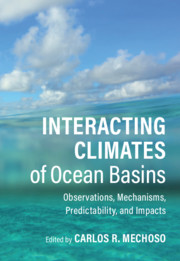Book contents
- Interacting Climates of Ocean Basins
- Interacting Climates of Ocean Basins
- Copyright page
- Contents
- Contributors
- Preface
- 1 Variability of the Oceans
- 2 Teleconnections in the Atmosphere
- 3 Atmosphere–Ocean Interactions
- 4 Interacting Interannual Variability of the Pacific and Atlantic Oceans
- 5 Indian Ocean Variability and Interactions
- 6 The Arctic Mediterranean
- 7 Combined Oceanic Influences on Continental Climates
- 8 Basin Interactions and Predictability
- 9 Climate Change and Impacts on Variability and Interactions
- Index
- References
2 - Teleconnections in the Atmosphere
Published online by Cambridge University Press: 13 January 2021
- Interacting Climates of Ocean Basins
- Interacting Climates of Ocean Basins
- Copyright page
- Contents
- Contributors
- Preface
- 1 Variability of the Oceans
- 2 Teleconnections in the Atmosphere
- 3 Atmosphere–Ocean Interactions
- 4 Interacting Interannual Variability of the Pacific and Atlantic Oceans
- 5 Indian Ocean Variability and Interactions
- 6 The Arctic Mediterranean
- 7 Combined Oceanic Influences on Continental Climates
- 8 Basin Interactions and Predictability
- 9 Climate Change and Impacts on Variability and Interactions
- Index
- References
Summary
This chapter is dedicated to a fundamental understanding of the physical mechanisms for connections between climates in remote locations or large-scale teleconnection patterns. It starts with a review of equatorial waves. This is followed by an introduction to conceptual models of the atmospheric response to tropical heating. Large-scale overturning circulations and their variability are described. The chapter ends with a discussion on how perturbations in the tropics propagate their effect on high latitudes in both hemispheres.
- Type
- Chapter
- Information
- Interacting Climates of Ocean BasinsObservations, Mechanisms, Predictability, and Impacts, pp. 54 - 88Publisher: Cambridge University PressPrint publication year: 2020
References
- 1
- Cited by



